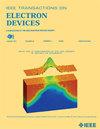Toward Understanding the Positive Shift of Reverse Turn-on Voltage in the Third Quadrant Operation in Planar SiC Power MOSFETs After Avalanche Breakdown
IF 2.9
2区 工程技术
Q2 ENGINEERING, ELECTRICAL & ELECTRONIC
引用次数: 0
Abstract
In this study, we explore the stability of third-quadrant characteristics in planar SiC power MOSFETs under high drain bias above the avalanche breakdown condition. By using experimental measurements and TCAD simulations, we analyze the mechanisms responsible for the positive shift of reverse turn-on voltage (对雪崩击穿后平面SiC功率mosfet第三象限工作中反向导通电压正位移的理解
在本研究中,我们探讨了雪崩击穿条件下高漏极偏压下平面SiC功率mosfet第三象限特性的稳定性。通过实验测量和TCAD仿真,我们分析了在第三象限运行过程中反向导通电压(${V}_{\text {rev}, \text {on}}$)正移的机制。当漏极偏置从1500 V增加到1620 V时,观察到阈值电压${V}_{\text {TH}}$出现明显的负偏移,而${V}_{\text {rev}、\text {on}}$出现明显的正偏移。TCAD模拟将这些变化归因于p阱区域内高电场引起的冲击电离。此外,在SiO2/SiC界面附近的栅极氧化物中加入正电荷作为空穴陷阱,模拟结果显示${V}_{\text {rev}, \text {on}}$的正位移与实验结果一致。这些发现表明,雪崩击穿条件下高漏极偏压引起的空穴捕获会影响平面SiC功率mosfet第三象限工作的稳定性。
本文章由计算机程序翻译,如有差异,请以英文原文为准。
求助全文
约1分钟内获得全文
求助全文
来源期刊

IEEE Transactions on Electron Devices
工程技术-工程:电子与电气
CiteScore
5.80
自引率
16.10%
发文量
937
审稿时长
3.8 months
期刊介绍:
IEEE Transactions on Electron Devices publishes original and significant contributions relating to the theory, modeling, design, performance and reliability of electron and ion integrated circuit devices and interconnects, involving insulators, metals, organic materials, micro-plasmas, semiconductors, quantum-effect structures, vacuum devices, and emerging materials with applications in bioelectronics, biomedical electronics, computation, communications, displays, microelectromechanics, imaging, micro-actuators, nanoelectronics, optoelectronics, photovoltaics, power ICs and micro-sensors. Tutorial and review papers on these subjects are also published and occasional special issues appear to present a collection of papers which treat particular areas in more depth and breadth.
 求助内容:
求助内容: 应助结果提醒方式:
应助结果提醒方式:


